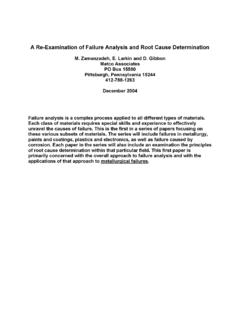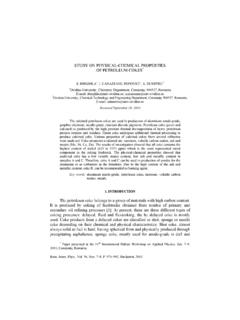Transcription of Failure mode analysis of plastic components & parts
1 Failure MODE analysis OF PLASTICS components & parts ABSTRACT The Failure mode of component sets limit to engineering design. Therefore, Failure Mode analysis should be part of the engineering design and manufacturing process. The two major engineering tasks in component applications are to perform Failure analysis (FA) and Failure Mode and Effects analysis (FMEA) The engineering problem solving approaches can be applied to determine Failure analysis of Plastics components used in engineering applications. However, it is important to define Failure mode and Failure mechanism. The Failure mode analysis effort conducted on polymer materials provides a good materials database for computer-aided design engineers which in turn can use the information to effectively model part reliability, thus reducing the need for complex and costly prototype testing.
2 Failure analysis (FA) Failure analysis consists of investigations to find out how and why something failed. The four major reasons for engineering failures are Poor design, incorrect use of material, manufacturing defects and service conditions. Understanding the actual reason for failures is absolutely required to avoid recurrence and prevent Failure in similar component, system, structure or product. The analysis should also help with the understanding and improvement of design, materials selection, fabrication or processing techniques, and inspection methods. Failure analysis is for identifying and understanding the physics of the Failure processes and mechanisms of Failure . Failure analysis has been in use for decades, and has resulted in considerable improvements in components reliability and system maintainability, even with overall system complexity increased.
3 Traditionally, Failure analysis methods have focused on laboratory testing and physical analysis of components to fully understand why component failed. Within the last 10years, great strides have been made in Failure analysis using computer-aided engineering, simulations and virtual testing that incorporate stress analysis equations derived from basic principles of physics and strength of material. The evolution of the computer industry, as well as the growth of available material information, has made computer-based Failure analysis more feasible than ever before. Failure analysis should identify the root cause analysis and recommendation of a corrective action(s). The Failure investigator has only one objective to determine the Failure mechanism that caused the Failure and to use that knowledge to prevent another occurrence.
4 Background Part information: Detailed information about a failed component often facilitates selection of analytical methods and can provide insight into some of the factors that may have contributed to the Failure . Certain test methods may be suggested by knowledge of the component manufacturing history, and this could lead to a quicker solution. This information should include as a minimum: specifications (material and component), manufacturing information, part number and serial number, and engineering drawings. Service condition: The history of a failed part is also of great importance to the engineering analyst. All information concerning the actual record of a part can serve to illuminate the causes of a Failure . Failure analysis investigation planning and sample selection: The planning portion of an investigation is crucial to determining the proximate cause of Failure .
5 Proper planning can ensure that an investigation is efficient and cost effective. Failure analysis criteria Proper background information Relevant analyses and tests Thorough knowledge of plastic material properties, manufacturing processing and service condition Engineering expertise and experience The theory must agree with the data. June 9th, 2008 American Engineering Group, Akron OH. The simplest solution is the best solution. Having the wrong solution is frequently much worse than having no solution. Major failures are often triggered by very minor engineering factors. Preliminary examination All pertinent features should be examined visually, and thorough notes should be taken for each component associated with a Failure analysis .
6 Many macroscopic features and characteristics can suggest certain Failure modes and circumstances. Fracture surfaces can exhibit an identifiable origin, progression marks, direction marks, and post fracture damage, all of which can be significant to the Failure . All of the pertinent features noted in the visual examination should be well documented by photographs. The component condition as well as any stamped information /part numbers should be illustrated. This should be done as soon as possible after Failure , especially if the fracture surfaces continue to corrode. If smaller sections are to be excised for analysis , this step can document their locations and orientations. Photography is necessary because subsequent dissection of the sample may preclude further visual examination.
7 Material evaluation Thoroughness material evaluation is an integral part of any Failure analysis . Naturally, a good engineering analysis will include test methods that are appropriate to the physical evidence of an investigation. The following tests should all be considered: Environmental testing: Environmental tests may simulate the corrosivity and temperature extremes experienced by a component in service. Either the failed part or an exemplar part that has been processed similarly could be subjected to these procedures, which may reveal behavior that could cause Failure . Mechanical testing: Mechanical properties have been historically measured by material suppliers and are often reported to the end user.
8 Properties measured on a failed material can often be directly compared to pertinent specifications and prior property data. Discrepant strength levels can be determined, and in many cases degradation of these properties during service can be identified. Determination of material structure can indicate the likely mechanical and physical properties of a component. Similarly, this examination can reveal crucial processing information, which may indicate incorrect or incomplete curing or other required structural alteration. Microscopy can reveal macrostructure, such as depth of surface hardening or banding, and it can also reveal microstructure, such as grain size and the phases present.
9 Carefully prepared cross-excellent depth of field, which is a boon to morphological identification. In addition to the fracture mode, electron microscopy can help identify types of mechanical damage, such as adhesive or abrasive wear, corrosion, and other distinct features. To some extent, surface roughness or machining quality can also be evaluated. Functional testing This group of tests includes all those that do not easily fit into the previous categories. The following are a few of the more important techniques. Fracture mechanics: This tool can approximate the stresses surrounding a fracture to better explain its occurrence. By making certain assumptions and isolating the fracture location, simulations of crack growth scenarios can be calculated.
10 By altering the determined model parameters, the analyst can estimate the magnitude of the mechanical stress applied to a component at the time of Failure . This is often used in tandem with NDE-measured flaw sizes to determine the reduced loads necessary to produce crack growth with a flaw of certain dimensions. Mechanical properties measured during destructive physical analysis can be placed in this model to acquire more specific information. June 9th, 2008 American Engineering Group, Akron OH. Finite element analysis : Finite element analysis , or FEA, is an advanced modeling technique that can help to predict the magnitude of stresses on individual components within complex assemblies.







